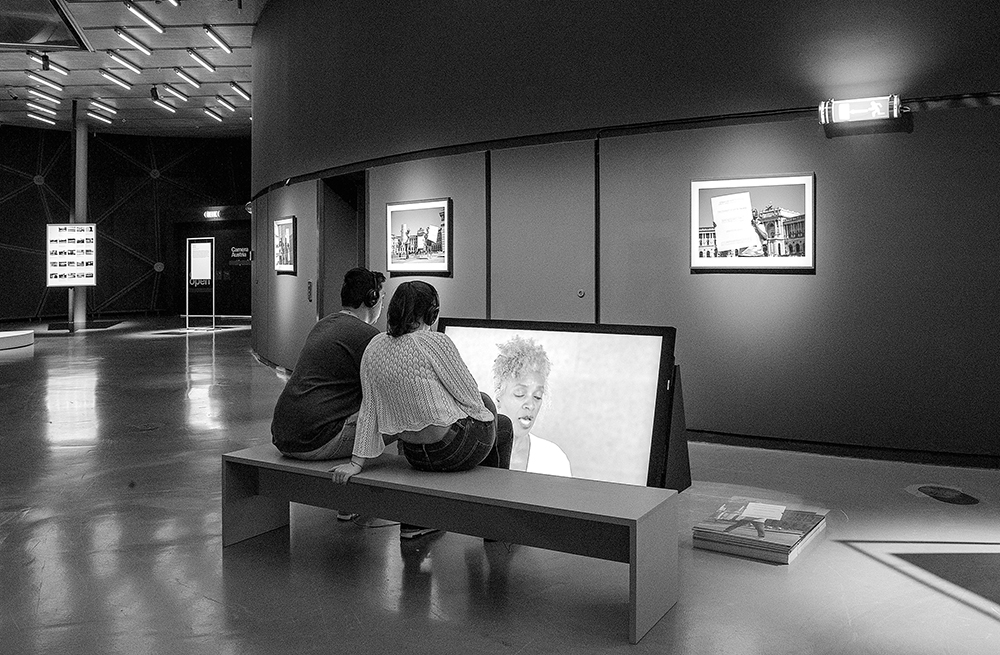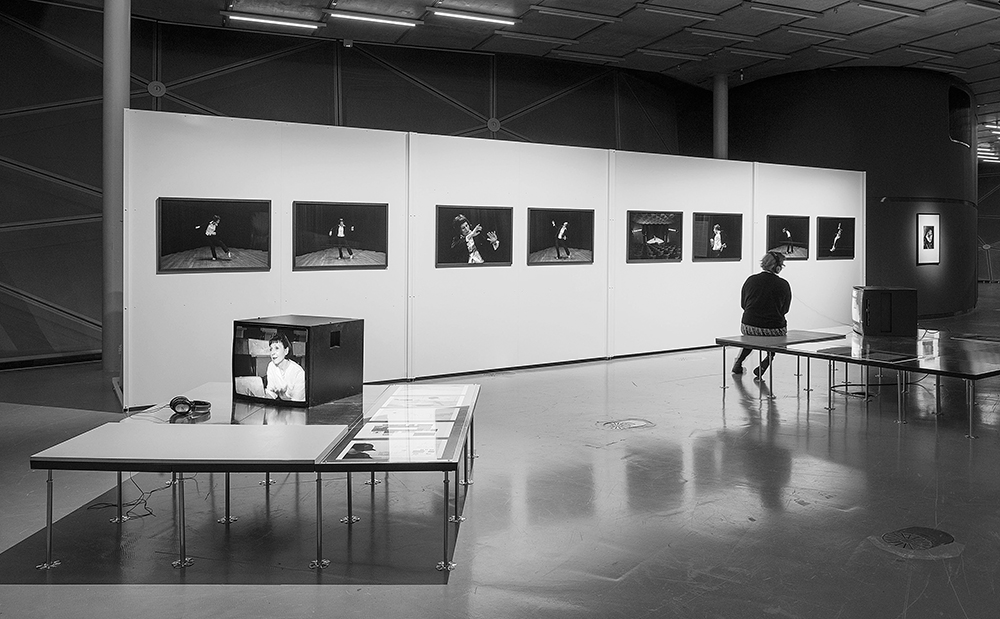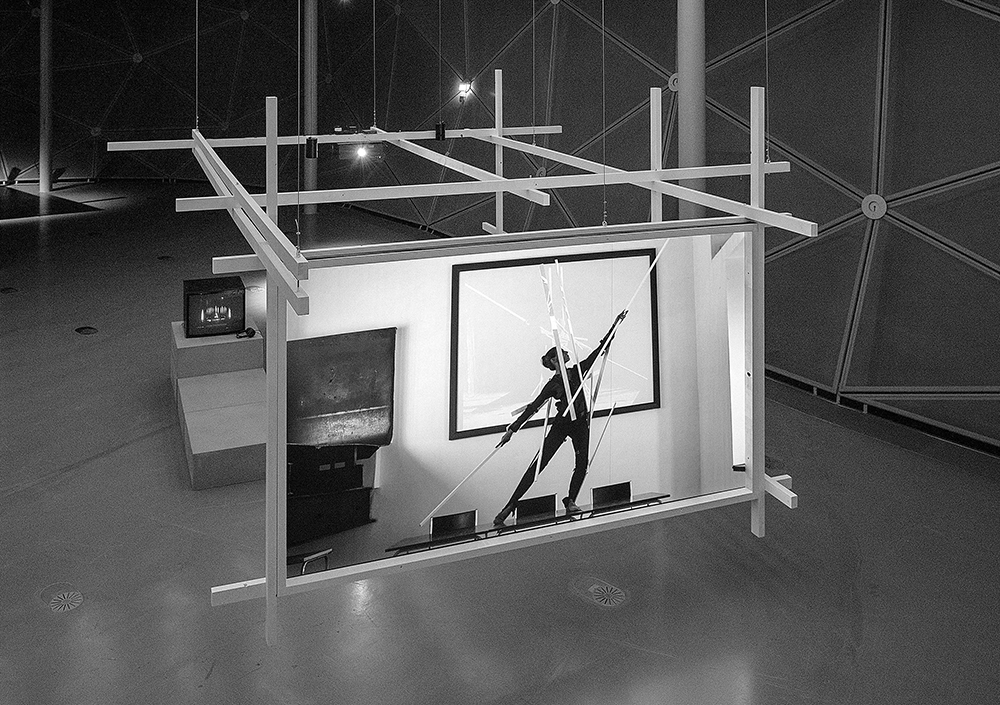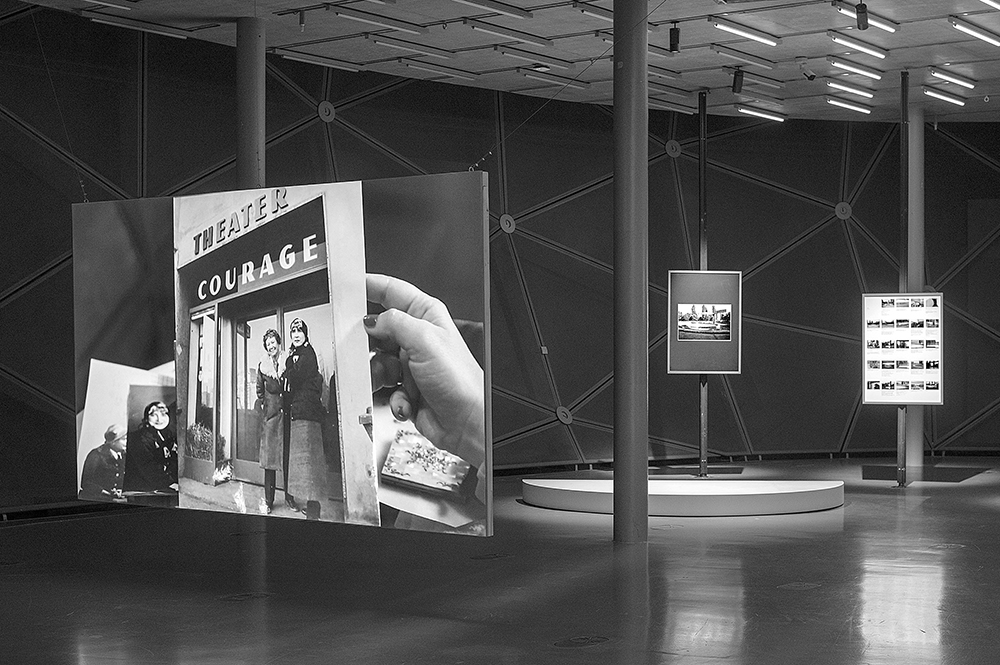Interview / Isa Rosenberger / Version 6
Version: In your recent works such as …das weite Land, woher sie kommt, MANDA, Café Vienne, or Courage, you focus on the life stories of mostly Jewish women and female artists from the 1930s. What draws you to these women?
Isa Rosenberger: What has been with me for a long time is an interest in these hidden, forgotten, and neglected stories, and often they are women’s stories. It actually started back in 2001 with a scholarship in Sarajevo. That’s when I began exploring the transformation processes in Eastern Europe and the associated economic developments. At some point, I realized I had to work with the history I’m rooted in as well. And when you engage with Austrian history, you quickly find yourself confronted with National Socialism. It’s about stories that are worth looking at again and perhaps activating for our present. I often came across these life stories via the places. A friend gave me a book about expressionist dance in Vienna during the interwar period, and that’s how I learned that these female dancers often performed in so called Volkshochschulen (adult education centers), especially in the Volkshochschule Ottakring, which was an important platform for the avant-garde culture of Vienna Modernism. The aim was to bring culture and advanced knowledge to the working-class suburbs. And for these dancers, who couldn’t perform in the opera houses, the Volkshochschulen were important stages. A lot of experimentation took place there, also as an expression of freedom. That’s how I came across Gertrud Kraus. Her socially aware approach and her engagement really intrigued me. She later emigrated to Tel Aviv and co-founded Israeli Modern Dance. In fact, she was almost forgotten once Martha Graham and Modern Dance from the USA became important in Israel. Later, she worked as a painter and sculptor and was a committed instructor.
Version: In your Bauhaus-inspired work MANDA, the education of women also plays a role in the background. Women were admitted to university on an equal footing by statute, but in practice things looked very different.
Isa: In practice, for most of the Bauhaus‘ existence, up to 90% of women were pushed into the weaving workshop. The only real exception was the stage workshop, which was facultative and didn’t require traditional craft training—this gave women a relatively large degree of freedom. My work explicitly addresses the fact that dance can never truly be a hierarchical relationship between choreographer and dancer. It’s always a dialogue, because only the dancer can determine what is physically possible and how a movement can be executed. This also ties into how Manda von Kreibig, who co-developed the Stäbetanz (Stick Dance) with Oskar Schlemmer, remains uncredited, while a whole myth was built around Schlemmer. …das weite Land, woher sie kommt and MANDA are closely connected for me—both, through the lens of dance, deal with reform pedagogy and the neglect of women’s achievements. The difference is that the Volkshochschule was more anti-elitist—we truly went into the working-class neighborhoods—while the Bauhaus was far more elitist. In both cases, however, it was about the approach of a new pedagogy, even if from very different perspectives.
Version: Performances like the have a strong fictional element, even though they are designed as a kind of reenactment. You usually collaborate with dancers, singers, or actors who bring their own interpretations into the work. What do these collaborations mean to you?
Isa: I would call them approximations because we simply cannot reenact what we don’t know. The concept of a temporary alliance is very important to me. By this I mean bringing together different skills and interests, in the case of dancers specifically their knowledge of the body. I am looking for the people with whom I can realize these projects. Andrea Amort, a dance historian from Vienna, recommended Loulou Omer to me. When we first met at a café, she told me that her mother had been a student of Gertrud Kraus in Tel Aviv. As a little girl, she would often walk down the street and hear piano music coming from a basement studio—that’s where Gertrud Kraus held her classes. Later, because her family was so poor, she received free training there. But it wasn’t just a dance education—it was an artistic education that also included music and painting. Loulou Omer herself plays piano, sings, dances, and speaks in the video. That’s what I mean by embodied knowledge— which was passed on to the mother via Gertrud Kraus and from the mother to the daughter and then comes back to this original stage.
Version: These original stages and locations are very important to you. They either serve as filming locations for your movies or shape the architecture of your installations. Even in earlier works like Nový Most or Ružinov, the architecture of the site plays a central role.
Isa: For me, places are carriers of memory, but also of ideas and knowledge.
Version: Could it be that we never really understood the ideas of modernism? Modernism is essentially about reduction. However, your film settings are very individually designed—like Café Jelinek, the wallpaper, the yellow-painted wall, the green table, or that elevated double floor. When we look at our spaces today, all the walls are white, and the floors are the same uniform gray, even in galleries and exhibition spaces. Are we taking modernism too seriously?
Isa: Now that you mention it, I realize how much Tim Ingold influenced me when I was researching the Bauhaus project. In A Brief History of Lines, he argues that everything—singing, dancing, speaking, storytelling, living—can be traced back to the line. This applies to Stäbetanz as well as to the broken life paths in this particular context. But he also writes that we always associate modernism with the straight line, which we connect to clarity but in reality is an irrational line that can actually lead to something totalitarian. I was fortunate to live for two months in the Oskar Schlemmer Master House, where I could truly experience where these ideas came from. Everything there is colorful and lovingly designed, down to the smallest details, even the door handles. The spaces radiate an astonishing sense of warmth and security. Much of that has been lost in contemporary architecture, leaving behind a form of reduction that often feels almost brutal and inhospitable. For Alexander Gottlieb Baumgarten—the philosopher who introduced the concept of aesthetics in the mid-18th century—aesthetics was the study of sensory perception. The entire body perceives something, and that’s precisely the idea I try to carry into my exhibitions. It’s also about our physical experience and an experiential space in which all the senses are challenged.
Version: There is the historical narrative, in the form of archive material, performances at places important to the narrative, you involve historians and scientists, the displays play an important role in guiding visitors … You create a dense network of references, approaching the subject from multiple perspectives. How do you develop these works? What is your process?
Isa: It’s always a process of feeling my way forward, where coincidence plays a big role. I come across something in my research that interests me and sets a direction. For example, I had this image of Stäbetanz hanging in my studio for a long time, and I knew I wanted to do something with it. Then, by chance, I read Tim Ingold and initially considered working on the historical Bauhaus stage. But I didn’t want to do a reenactment, and besides, that stage carries too much ideological weight for me. At some point, I joined a tour through the Bauhaus storage depots, and I thought this to be the right place. On one hand, these depots hold what has been deemed valuable enough to preserve; on the other hand, they are also spaces of forgetting, where objects may collect dust for decades. And it is also the place that stands for everything that is not collected— historically, this is often the art of women and performative art. This layering of meanings led me to shoot the video there. Filming in a museum depot, surrounded by valuable artifacts, was a bit complicated—two staff members had to accompany us at all times. Over three days, dancer Celia Millan and I explored the entire depot, taking photos and discussing what might make for interesting scenes. From there, we developed the shooting plan. That was a joint approach.
Version: Even though your work focuses on the stories of these women and the disruptions in their lives, it constantly reflects on contemporary situations—especially given the current political climate. Do you think history repeats itself, particularly when it hasn’t been fully reprocessed?
Isa: That’s a fundamental guiding principle for me. When I engage with the past, I’m always engaging with the present and the future as well. I really like the subtitle of Kurt Kladler’s text (in Schatten, Lücken, Leerstellen) Wenn die Gegenwart Licht und Schatten auf die Vergangenheit wirft. We always look at history through the lens of our present. The shadows of the past are not separate from the present and our experiences. Remembering, in itself, is an active, imaginative, and creative process. I don’t believe we can truly reconstruct what actually happened—memory is always partly imaginative. But we can attempt to approach it, to come closer, and to find forms of action that might be inspiring. In Espiral, I very explicitly tried to express that while history doesn’t repeat itself one-to-one, echoes of the past keep resurfacing in spirals. And we can look at how others have dealt with similar situations before us.
Version: Can remembering really be an act of resistance? After all, everyone should know what happened 70, 80 years ago. Do you think opening up spaces of remembrance can strengthen resistance?
Isa: I find it exciting to point out what has been and to what extent this can be an inspiration. Stella Kadmon, for example, returned to Vienna on the first ship after the war and founded Theater der Courage in 1948. By 1960, it had moved into the space at Franz-Josefs-Kai, where it remained. As a Jewish woman, she was deeply committed to antifascism. Emmy Werner, in my piece Courage, recalls that the theater’s productions addressed socio-political issues, including abortion, some of which were broadcast live on ORF. These productions ignited public debates, aiming to generate impact and develop models for action that remain relevant today.
Version: Is this about self-empowerment or self-efficacy of women or migrants?
Isa: One of the starting points for …das weite Land, woher sie kommt was Gertrud Kraus’ 1934 stage production Die Stadt wartet, which was based on Maxim Gorky’s fairytale Musik der Großstadt. It tells the story of a young boy leaving the countryside for the city, torn between the fear of forgetting what he left behind and the excitement of what lies ahead. For me, it was an obvious link to contemporary migration issues. That’s why I organized a workshop at an adult education center with young migrants. It was a very pragmatic approach—we used drawing and dance to retrace their journeys to the city. And in doing so, something really beautiful emerged. There’s also a historical parallel: Gertrud Kraus had to emigrate to Palestine, while these young people have mainly immigrated from this Arab region.
Version: You frequently work with marginalized groups, like in Monument for the Women’s Center, where you collaborated with former female workers from an East German film factory, or in Got it Rough ’Cause I Am a She, where you worked with three women at risk of homelessness who now live at VinziRast in Vienna.
Isa: Yes, most of the people I’ve worked with are women. In a way, they are all experts—experts of everyday life. It’s not about self-empowerment in the way you mentioned earlier but rather about exchanging knowledge, generating it collectively, making it productive, and sharing it. All projects are actually also about questions of economics and the interaction between the individual, the social framework and the room for agency we have ourselves. In the same year (1928) that Manda von Kreibig developed Stäbetanz, Lu Märten was at the Bauhaus. As early as 1914, the writer and women’s rights activist wrote in Die Künstlerin that the new capitalist development had never been followed by a reorganization of private space. She had already analyzed what we now call care work, recognizing that it always fell to women. And this topic is also echoed in the work with the women from VinziRast when it is mentioned that the Covid pandemic has disproportionately affected women because care work is still mostly done by women and domestic violence has also increased significantly.
Version: How do you approach these women? What role do you take in this collaboration? You’re usually in a different position than them in that moment.
Isa: That’s a delicate question, of course. In these temporary alliances, we all bring our interests and skills to the table—including me. I make my expertise available just as they do. For example, with the women at risk of homelessness, we met as artists. Margaret Carter is a jazz singer who performs at Porgy & Bess and was an officer in the U.S. military—a remarkable woman who now lives at VinziRast for various reasons. Another woman studied fine arts in Odesa and has an impressive exhibition record. The third comes from the textile industry. These are all highly skilled women. I contribute my artistic expertise. Each project is different, and my role shifts between initiator, workshop leader, director, and producer. And I want to emphasize—everyone is paid for their participation.
Version: In Espiral, you examine economic exploitation structures, particularly in Southeastern Europe, and reference Kurt Jooss’ dance theater piece Totentanz in acht Bildern. In addition, you integrate text elements about Austrian financial imperialism. Can you explain this connection?
Isa: I’ve worked on several projects about transformation processes in Eastern Europe. When I was invited to an exhibition in Zagreb with artist Kristina Leko, we walked through the city, thinking about our respective topics. Everywhere we looked, there were Austrian banks—Raiffeisen, ERSTE, and so on. This was in 2010. Around that time, I came across an image of the Lübeck Totentanz and, in my research, discovered Kurt Jooss’ ballet Der Grüne Tisch (1932). Jooss was also inspired by the Totentanz. His piece is considered the first political ballet—it translates his experiences of the global economic crisis, the Weimar Republic, and the rise of fascism into dance. At “the green table”, powerful men in black negotiate everything—a metaphor for casino capitalism. I wanted to transpose his ballet into our present time and began searching for a dancer. That’s how I found Amanda Piña. When we first met, she told me she had studied at a dance school in Santiago de Chile founded by one of Jooss’ students. The school is called Centro de Danza Espiral. That gave me two spirals I could connect—one being the financial spiral and Austria’s aggressive expansion into new EU markets. The Chilean-Austrian dancer Amanda Piña provides the link to Chile, which was a model for neoliberalism. With Kurt Jooss, his student Patricio Bunster, and the Centro de Danza Espiral, the story is told of a resistant aesthetic that continues to have an impact today. The school was and still is a socially engaged project, providing dance education to children from low-income backgrounds.
Version: History is always something constructed in retrospect — depending on what is suppressed or concealed for whatever reason. How do you ensure that you don’t simply create another constructed narrative?
Isa: Of course, I construct history too. But I try to make that construction visible. I provide insight into the process and the research materials—many of which are also exhibited. And there’s an added layer through expert interviews. Nora Sternfeld has described it as not being about closing the gaps. The empty spaces that fascinate me are always projections—they make me think. Keeping them open, shifting perspectives, and creating movement within them—that’s what interests me. Revealing, concealing, making things semi-transparent without obscuring them again. At Kunsthaus Graz, the exhibition space is so vast that multiple works stand side by side. Visitors can create their own narratives as they move through the space, deciding where to pause and listen. In that way, new stories can unfold—because so many layers overlap.
Version: Would you describe yourself as a storyteller?
Isa: Yes. That’s a beautiful term—I can definitely relate to that. Telling history, telling stories.




